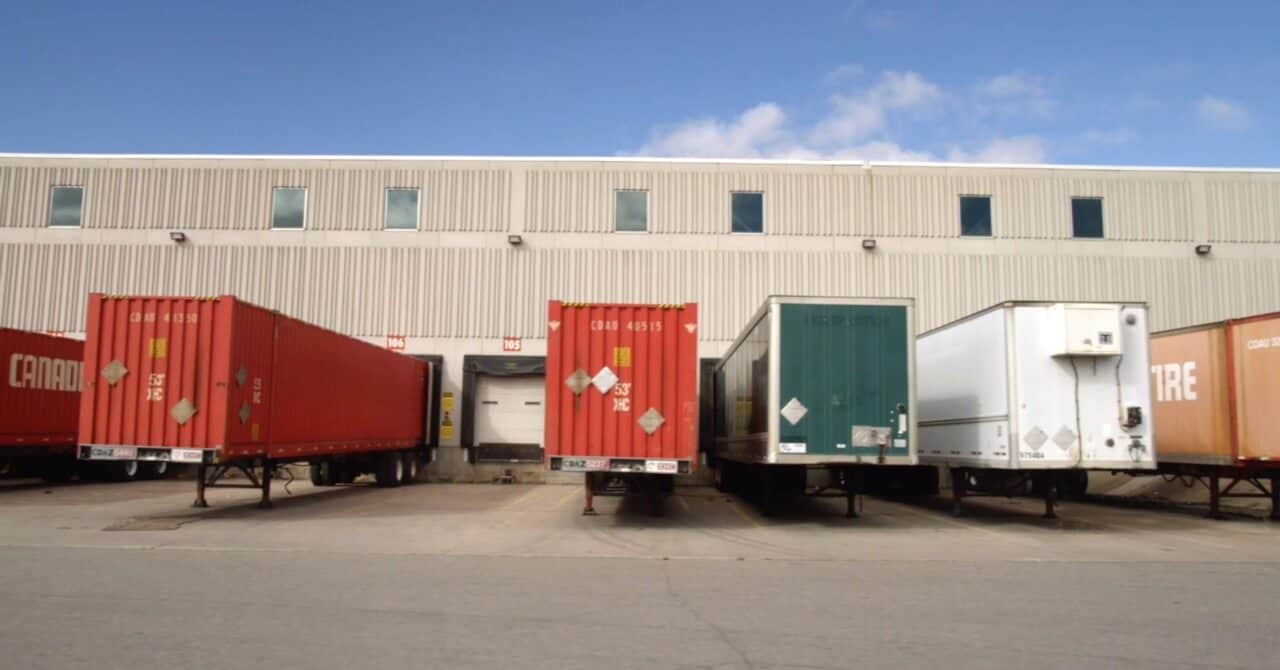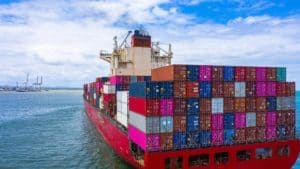Issue 30: September 2022 LMI Report, Freight Companies Face Weak Peak Season & More

A Word from Legacy
It seems like last month’s Shipment is still hot off the presses, but here we are again, ready to serve up some of the biggest news stories in the logistics industry today.
From low water levels in the Mississippi River impeding commercial traffic to a pending nationwide railroad strike (yes, again), we’ve got some pretty major stories to cover in this issue, so let’s start things off on the right foot with our Market Update.
Market Update
High Inventory Levels Serve as Key Driver Behind September 2022 LMI Reading
The September 2022 Logistics Managers’ Index (LMI), released on October 4, came in at a reading of 61.4, up 1.7 points from August’s reading of 59.7. This slight uptick follows a seven-month-long freefall from the March 2022 LMI’s all-time high of 76.2 and indicates sustained growth in the logistics industry due to high levels of inventory and their associated costs and utilization.
The September 2022 LMI paints a complicated picture of an industry in a state of disarray. While the warehousing sector continues to see high rates of utilization, the transportation sector is in the midst of a major slump (more on that in our main stories).
As has been the case for the better part of the year, high inventory levels continue to move throughout the global supply chain. These high inventory levels — which reached a reading of 71.9, denoting significant expansion — are a byproduct of strong consumer demand that suddenly evaporated in the face of rising inflation. Consumers have since shifted their spending to services, rather than consumer goods, creating a bear market and prompting concern from investors.
Naturally, this excess of inventory has driven up associated costs and placed strain on available warehousing space.The LMI’s Warehousing Capacity Index for September remained firmly in contraction territory at a reading of 44.3, marking the 25th consecutive month of contraction. Meanwhile, the Warehousing Utilization Index reached 76.8 — the second highest reading in the history of this metric — while the Warehousing Prices Index came in at 75.4.
Major firms such as Target and Walmart have responded to these challenges by aggressively discounting goods in the interest of offloading inventory, which has placed pressure on smaller retailers — including those that are not presently carrying excess inventory — to do the same. Another interesting development we’re seeing in response to idle inventory is an increased investment in warehouse automation from retailers. As the official LMI report notes:
“The hope is that by increasing the use of robotics, [retailers] will be able to combat both the labor and facility shortage and increase capabilities to fulfill online orders out of stores and other sites they may own already.”
Though there is some speculation that inventories will begin to move once goods spending picks up in Q4, at present, inventory is moving through the supply chain at a much slower rate than it has over the past two years.
On the transportation side, the Transportation Capacity Index jumped up 7.5 points from August 2022 to a reading of 71.8, the second-highest rate for this metric in LMI history. As capacity has gone up, prices have gone down, with the Transportation Prices Index dropping 3.5 points to a reading of 44.5, creating favorable terms for shippers. The LMI report notes that although delivery companies are projected to handle approximately 92 million parcels during the 2022 holiday shopping season, this is well below the 110 million packages’ worth of available capacity firms have built up, which will further soften transportation prices.
Certain parcel carriers, such as FedEx and UPS, have attempted to combat rising fuel costs and waning demand by increasing their rates, but this approach may prove unsustainable in the long term. The present transportation slump certainly spells good news for shippers, who have the opportunity to capitalize on excess capacity and lower prices.
Looking ahead, industry experts anticipate that we’ll see a steady return to normal over the coming year, with relief in warehousing capacity and moderation across all cost/price metrics. Warehousing prices and transportation capacity may remain elevated, albeit at lower levels, and inventory levels are likely to reach more moderate levels as firms work through backlogs.
For an overview of the September 2022 LMI across all indices, please refer to the chart below:
| LOGISTICS AT A GLANCE | |||||
| Index | September 2022 Index | August 2022 Index | Month-Over-Month Change | Projected Direction | Rate of Chage |
| LMI® | 61.4 | 59.7 | +1.6 | Growing | Slower |
| Inventory Levels | 71.9 | 67.6 | +4.4 | Growing | Slower |
| Inventory Costs | 77.2 | 76.8 | +0.4 | Growing | Slower |
| Warehouse Capacity | 44.3 | 42.3 | +2.1 | Contracting | Faster |
| Warehouse Utilization | 76.8 | 65.3 | +11.5 | Growing | Slower |
| Warehousing Prices | 75.4 | 75.0 | +0.4 | Growing | Slower |
| Transportation Capacity | 71.8 | 64.3 | +7.5 | Growing | Slower |
| Transportation Utilization | 61.1 | 51.6 | +9.5 | Growing | Slower |
| Transportation Prices | 44.5 | 48.0 | -3.5 | Contracting | Faster |
Logistics at a Glance chart depicting — across various indices — month-over-month change from August 2022 to September 2022, projected direction and rate of change.
Also in Today’s Shipment:
- Freight companies prepare for the worst as high inventory levels drive low shipping demand.
- Shippers seek alternative routes as low water levels in the Mississippi River threaten the U.S. supply chain.
- Terminal congestion and ongoing labor talks deter shippers from West Coast ports.
- U.S. economy braces for impact as renewed concerns around nationwide railroad strike loom large.
In the News

Weak Peak: Freight Operators Stare Down Peak Shipping Season Slump
Things are looking grim for trucking and rail intermodal companies as they approach this year’s peak season, which is slated to run until mid-December.
Though peak season has traditionally been a major event for freight companies, high inventory levels prompted many retailers to cancel overseas orders during ocean carriers’ peak season, which ran from July to September. This caused container rates to collapse and left carriers scrambling to cancel voyages in an attempt to pull capacity out of the market. Major ports along the West Coast saw weak import volumes, with the Port of Los Angeles reporting that it handled the fewest number of loaded import containers for the month of September since the Great Financial Crisis of 2009.
Low import volumes translate to substantially reduced demand for trucking and rail intermodal companies. As reported in the Wall Street Journal:
“Trucking bellwether J.B. Hunt Transport Services Inc. on Tuesday evening reported that revenue remained flat in the third quarter compared with the prior quarter at $3.84 billion and that the company anticipates a weakened peak season.”
This precipitous drop in demand has caused freight rates to plummet and capacity to open up, which comes as a relief to shippers after a prolonged period of sky-high rates and limited capacity.
Freight companies, by comparison, are not amused. Although leading industry publications such as Freightwaves predicted a freight recession as early as Q1, a stable June gave trucking company executives cause for cautious optimism. However, that increase in demand proved temporary, as the SONAR Outbound Tender Volume Index — which measures truckload requests from shippers to carriers — fell by 8% in Q3 and by an additional 3% this month.

Drying Mississippi River Creates Downstream Supply Chain Issues
Low water levels in the Mississippi River watershed could spell disaster for the U.S. supply chain. Although water levels along the Mississippi River are traditionally low during the month of October, a lack of rainfall in the Ohio River Valley and the Upper Mississippi has contributed to the eighth-lowest water level on record, increasing the risk of commercial vessels running aground on sandbars. The Coast Guard Sector Lower Mississippi River reported eight groundings for the week of October 4 alone, an unprecedented number for this time of year.
The U.S. Army Corps of Engineers has begun emergency dredging, with a total of 21 river blockages either dredged or slated to be dredged, and the U.S. Coast Guard has placed restrictions on the depth commercial boats and barges can sit in the water. Barge operators have also reduced their tow size from 36 barges to 25. Despite these efforts, there are concerns as to whether they’ll be enough to resume commercial traffic — especially since additional rainfall is unlikely to come anytime soon. The National Weather Service predicts a prolonged dry-spell for the Lower Mississippi, with the potential for the river to drop 10 feet below its normal stage through November 3.
“America is going to shut down if we shut down,” said Mike Ellis, chief executive of American Commercial Barge Line LLC in a new report from the Wall Street Journal. Ellis also noted that there have been multiple occasions in recent days where a barge tow hit a sandbar with such force that it disconnected from the barge it was transporting.
Despite it being the peak of harvest season for key agricultural products, including corn, soybeans and grain, farmers have struggled to move crops and dry goods. The U.S. Department of Agriculture reported that, during the week of October 1, just 154,450 tons of corn were transported — a 49.9% drop from 2021 and a 55.1% drop from 2020. Without the ability to easily transport goods, prices have increased, placing additional strain on consumer wallets already stretched thin from rising inflation.
Restrictions on the Mississippi River have prompted many shippers to seek alternative supply routes, including rail and trucking routes; however, neither offers a perfect solution. Rail, in particular, is plagued by its own set of challenges: Despite labor unions and management reaching a tentative deal at the eleventh hour, narrowly averting a railroad strike in September, the possibility of a strike is now back on the table due to railroads’ rejection of a major union’s sick leave demands.

Port of LA Sees Low Cargo Volumes as Shippers Lose Confidence
As noted in an earlier story, the Port of LA has seen substantially lower import volumes this peak season, in part due to retailers carrying excess inventory and canceling overseas shipments. However, that’s far from the only contributing factor: Terminal congestion, prolonged chassis dwell times and concerns surrounding ongoing negotiations between the Pacific Maritime Association (PMA) and the International Longshore & Warehouse Union (ILWU) have also prompted shippers to take their business elsewhere.
In an October 19 press briefing, Port of LA Executive Director Gene Seroka stated that container volumes for the month of September dropped 21.5% year-over-year and that the average street dwell time for chassis currently stands at 10 days, when it should be four. Seroka also noted that he expects shippers to continue to reroute cargo to ports along the eastern Gulf Coast until a labor agreement is in place.
Seroka addressed this last point in an interview with Bloomberg, suggesting that shippers’ fears were based on perception alone. “That’s a shift in cargo that took place — premeditated — months ago, because folks had trepidations about any type of prolonged discussion with these labor contracts,” said Seroka. “We’ve got to do our level best to recapture what has moved and continue to grow our share.”
That may prove challenging, given that the Port of LA cannot support the round-the-clock operations many shippers have come to expect, and now that bottlenecks along the East and Gulf Coasts — which had prompted some shippers to contemplate a return to the West Coast — have started to dissipate.
Despite the current slowdown, 2022 still proved to be the Port of LA’s second busiest year to date. The recent slump in imports and cargo diversions hasn’t been all bad news, either; it gave the Ports of LA and Long Beach the chance to finally eliminate the queue of container ships along the Southern California coast. And although it could take months yet for PMA and ILWU to reach an agreement, once terms are settled, we’ll likely see an increase in cargo volumes at ports along the West Coast as shippers regain their confidence.

Concerns Around Labor Strike Renewed as Railroads Reject Union Terms
Just when it seemed as though fears of a nationwide railroad strike were finally put to bed, they’ve reared their ugly heads yet again — this time over a disagreement concerning paid sick leave.
During the week of October 17, the National Carriers’ Conference Committee (NCCC), which represents most Class I railroads in bargaining, rejected a demand from the Brotherhood of Maintenance of Way Employees (BMWED) Division of the International Brotherhood of Teamsters, the third largest railroad union in the country, for seven paid sick days. For reference, unions had pushed for 15 days of paid sick time per year during initial negotiations, but this was rejected by the Biden administration’s presidential emergency board (PEB).
In its official statement, the NCCC responded to the BMWED’s request, saying that:
“The latest BMWED request for additional benefits is similar to a proposal which was carefully considered and rejected by President Biden’s [PEB] and comes weeks after the union entered into a tentative agreement that included the most generous wage package in almost 50 years of national rail negotiations.”
For its part, BMWED spokesman Clark Ballew said in a statement that the union’s request is “not unreasonable” and that “the railroads can very easily afford it, and they’d still be making record profits if they agreed to provide railroad workers paid sick leave.”
At present, six of the 12 railroad unions that represent some 115,000 workers nationwide have ratified their agreements, and a remaining five are expected to vote in the coming weeks. According to an NCCC timeline, should BMWED move to strike, they could do so as early as November 19. Such a strike would disrupt an already fraught supply chain, creating substantial issues for firms in the lead up to the holiday shipping season; according to an estimate from the Association of American Railroads, a strike could cost up to $2 billion in economic losses per day.
Not all hope is lost, though. In addition to emphasizing the importance of listening to and respecting railroad workers’ needs and interests, Peter Kennedy, director of BMWED’s strategic coordination and research, expressed optimism about the outcome of the negotiations.
“Ultimately, I remain confident that we’re going to get our temporary agreements ratified and be able to avoid a strike,” said Kennedy, adding that a strike is “a possibility, but I don’t think it’s a probability.”
This month has certainly given us a lot to consider, especially with holiday shipping season just around the corner, and we’re sure next month’s Shipment will do the same. Until that time, we encourage you to check out our blog or resource center, or reach out to the Legacy team directly to see how we can support your shipping needs.
Thanks again for joining us — we’ll see you soon.
Get Insights. Stay Ahead.
Get the latest news and insights via email on warehouse improvement, transportation optimization, labor strikes and international shipping rate changes.Popular Posts
Search Posts
-
2024 Q1 Freight Landscape: Trends, Challenges, and Predictions
As the first quarter of 2024 comes to an end, here are some observations over the past few months as well as predictions about the trucking...
+ Read more -
Baltimore Bridge Impact Assessment – Update
Following the recent Baltimore Bridge collapse and subsequent port closures, we want to keep our customers informed about the situation and...
+ Read more -
Global Momentum Builds for Charge on Global Shipping Sector’s CO2 Emissions
A growing coalition of 47 countries, including key players like the European Union, Canada, Japan, and various Pacific Island nations, is...
+ Read more









